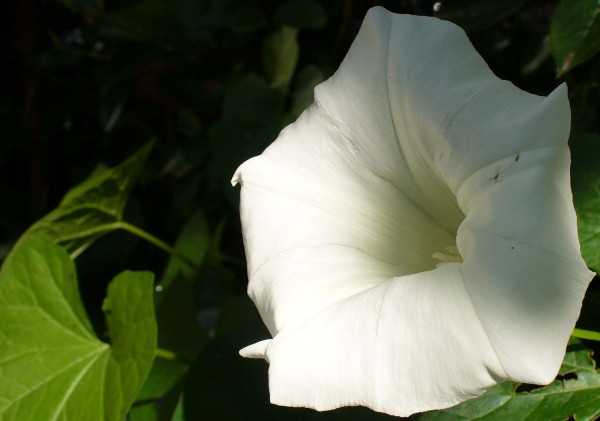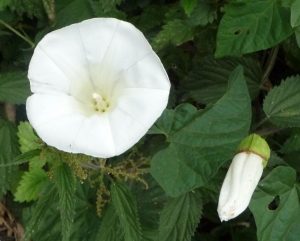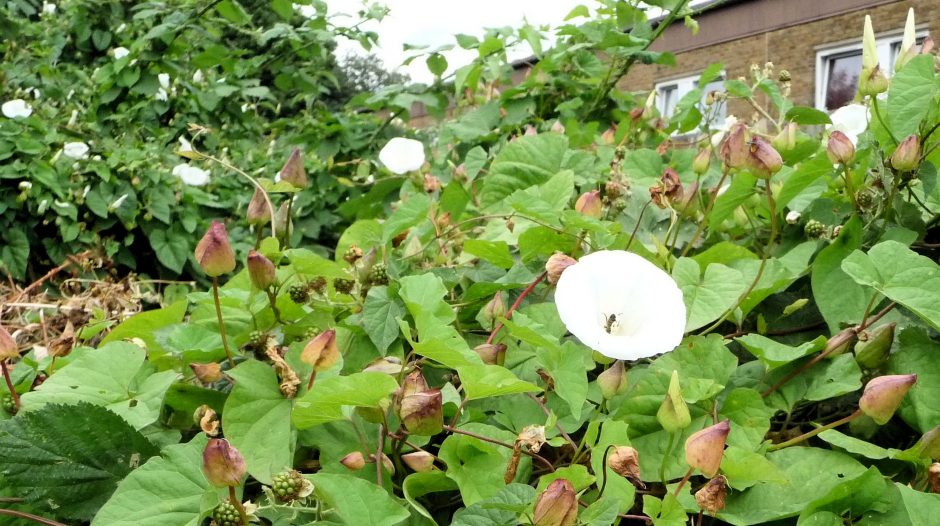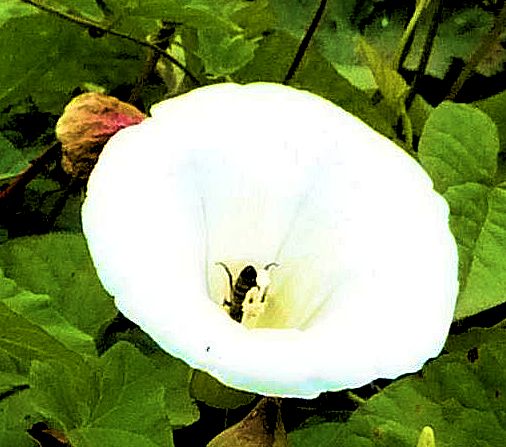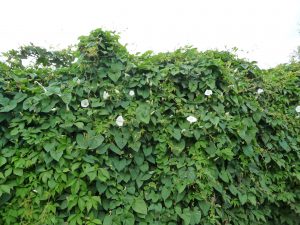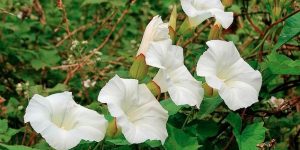HEDGE BINDWEED (Calystegia sepium)
North America, Europe, Asia & Africa
Calystegia sepium is a climber, a familiar sight in towns, gardens, woodlands & open spaces. Its tendrils appear in March & the plant twines its way upwards, wrapping itself round anything with which it comes into contact. Leaves are arrow-shaped & bottle green. Large, elegant WHITE trumpet flowers appear from July to September.
Bees’ Favourite.
As a nectar source, Hedge Bindweed attracts pollinators. Bees, Butterflies (Gatekeeper/Hedge Brown) and Hoverflies are attracted to the flowers, which are said to remain open all night and be pollinated by night-flying moths. This is also a larval food plant for The Convolvulus Hawk Moth.
But whatever points this wildflower may score with its services to wildlife, its habit of relentlessly smothering everything in its path has made it the bane of gardeners. It can grow to 4 metres, overwhelming all other plants it encounters on its way. Some of its roots have been found at 23 feet below ground level, and digging out the root system will be labour lost for the gardener if any piece of root is left; a new plant will grow from that piece.
Warning : Invasive
Hedge Bindweed or Wild Morning Glory : An Invasive Species in B.C.
The author of this article, Linda Crampton, tells you everything you need to know about the plant, how it grows & how to deal with it. She took all of the photographs.
“Calystegia sepium is native to eastern North America and is an introduced plant in British Columbia. Some people claim that it’s native to other areas. Its history is a little murky. The plant can be found in Europe, Asia and New Zealand as well as in the United States and Canada. In British Columbia, it’s classified as an invasive plant, a noxious weed or a nuisance plant, depending on the organization that’s classifying it. It’s also classified as invasive in at least part of Washington in the United States. Washington is British Columbia’s southern neighbour.”
“Interestingly, the plant is not classified as a nuisance everywhere in North America, especially in the eastern portion of the continent. Some people actually like its ability to cover unsightly objects and appreciate the beauty of its flowers.”
https://owlcation.com/stem/The-Hedge-Bindweed-or-Morning-Glory-An-Invasive-Plant
Manage Weeds on Your Farm . A Guide to Ecological Strategies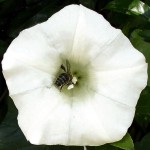
This PDF says that Hedge Bindweed originated in Eurasia, Africa and eastern North America, and has been introduced into New Zealand. There is great detail about how the plant manages to be so invasive. A tap root that can go down 23 feet, etc. One successful trial it quotes involved planting forage crops that shaded out the Hedge Bindweed. We may not have a farm on which the plant is making inroads, but this PDF may be of interest…
Charles L. Mohler, John R. Teasdale &, Antonio DiTommaso, (416 pages)
SARE/ Sustainable Agricultural Research and Education, 2021
thephilosophergardener/Life is Beautiful
Calystegia sepium, the other bindweed
“Conditions are perfect for digging. It is cold, the air is 3 Celsius, but not frosty. The sun is gaining strength in a cloudless sky. I can work in short sleeves as is my preference. The moisture level of the soil is optimal – neither too dry nor too wet and I can dig without damaging its structure. … Calystegia sepium, common bindweed. As I dig the now bare border, I can feel the thongs of it break on the tines of my fork. I become avian, stooping to pick out the smallest worms of the long white roots. I have seen it re-grow from a piece as small as 1cm or 3/8″ from as deep as 30cm/12″, such is its vigour.”
https://philosophergardener.com/
Other names: Bearbind, Bellbind, Belle of the Ball, Bethwind, Bine Lilies, Bride’s gown, Bugle vine, Campanelle, Corn Lily, Creeping Jenny, Cups, Daddy White-Shirt, Devil’s Nightcap, Duil Mhial (Gaelic), German scammony, Gramophones, Grandma’s Nightcap, Granny-pop-out-of-bed, Granny’s Night Bonnet, Harvest Lily, Heavenly trumpets, Hedge Bell, Hedge-Strangler, Hellweed, Hooded Bindweed, Holland Smocks, Lady’s Nightcap, Lady’s Shimmy, Lady’s Smock, Lady’s Umbrella, Larger Sunshade, Lily Vine, London Bells, Old man’s nightcap, Pisspot, Robin-run-in-the-hedge, Rope bind, Ropewind, Rutland beauty, Shimmies, Shimmies and Shirts, Shimmy and Buttons, Strangleweed, Wedlock, White bindweed, White Smock, White Witches Hat, Wild Morning Glory, Withy-vine (‘unchanged for 1,000 years’), Withy-weed, Withy-bind, Wood Vine.
Horwood says it is ‘emblematic of obstinacy’, with folknames of ‘Devil’s Guts’ and ‘Devil’s Garter’ *.
A R Horwood, BRITISH WILD FLOWERS in their Natural Haunts, The Gresham Publishing Company Ltd, 1919.*
International names: Corretjola blanca (Catalan), Opletnik plotni (Czech), Snerle, gaerde- (Danish), Winde, haag- (Dutch), Kalistegio hega (Esperanto), Seatapp tara- (Estonian), Karhunkoynnos (Finnish), Couronne de Notre Dame, Manchette de la vierge (French), Winde, grosse (German), Sovenyszulak (Hungarian), Mariuklukka (Icelandic), Campanelle bianche (Italian), Diztitenis zogu (Latvian), Kuopdanga tvoru (Lithuanian), Vindel, strande- (Norwegian), Kielisznik zaroslowy (Polish), Bons-dias (Portuguese), Cupa vacii (Romanian), Duil Mhail (Scots (Gaelic), Povoja plotna (Slovak), Plotni slak navadni (Slovene), Correguela mayor (Spanish), Snarvinda (Swedish), Boled olwen (Welsh (Cymraeg).
metabyte_data Multilingual European Flora Dictionary : Plant names listing for Calystegia sepium – Mozilla Firefox
